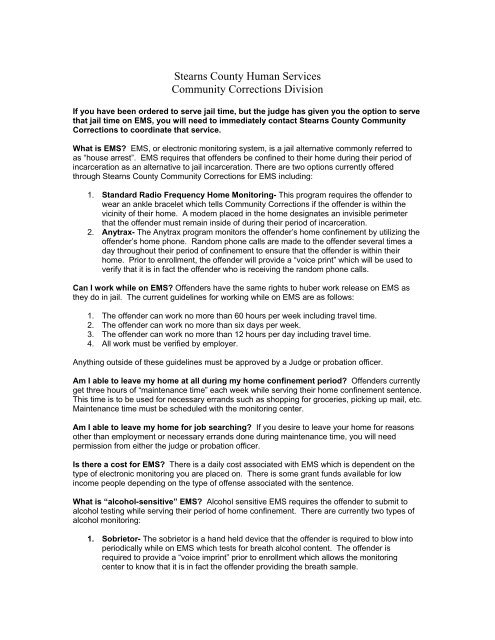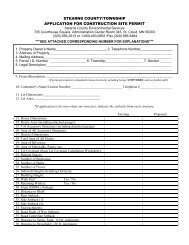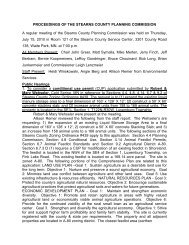Frequently-asked questions about electronic monitoring
Frequently-asked questions about electronic monitoring
Frequently-asked questions about electronic monitoring
You also want an ePaper? Increase the reach of your titles
YUMPU automatically turns print PDFs into web optimized ePapers that Google loves.
Stearns County Human Services<br />
Community Corrections Division<br />
If you have been ordered to serve jail time, but the judge has given you the option to serve<br />
that jail time on EMS, you will need to immediately contact Stearns County Community<br />
Corrections to coordinate that service.<br />
What is EMS? EMS, or <strong>electronic</strong> <strong>monitoring</strong> system, is a jail alternative commonly referred to<br />
as “house arrest”. EMS requires that offenders be confined to their home during their period of<br />
incarceration as an alternative to jail incarceration. There are two options currently offered<br />
through Stearns County Community Corrections for EMS including:<br />
1. Standard Radio Frequency Home Monitoring- This program requires the offender to<br />
wear an ankle bracelet which tells Community Corrections if the offender is within the<br />
vicinity of their home. A modem placed in the home designates an invisible perimeter<br />
that the offender must remain inside of during their period of incarceration.<br />
2. Anytrax- The Anytrax program monitors the offender’s home confinement by utilizing the<br />
offender’s home phone. Random phone calls are made to the offender several times a<br />
day throughout their period of confinement to ensure that the offender is within their<br />
home. Prior to enrollment, the offender will provide a “voice print” which will be used to<br />
verify that it is in fact the offender who is receiving the random phone calls.<br />
Can I work while on EMS? Offenders have the same rights to huber work release on EMS as<br />
they do in jail. The current guidelines for working while on EMS are as follows:<br />
1. The offender can work no more than 60 hours per week including travel time.<br />
2. The offender can work no more than six days per week.<br />
3. The offender can work no more than 12 hours per day including travel time.<br />
4. All work must be verified by employer.<br />
Anything outside of these guidelines must be approved by a Judge or probation officer.<br />
Am I able to leave my home at all during my home confinement period? Offenders currently<br />
get three hours of “maintenance time” each week while serving their home confinement sentence.<br />
This time is to be used for necessary errands such as shopping for groceries, picking up mail, etc.<br />
Maintenance time must be scheduled with the <strong>monitoring</strong> center.<br />
Am I able to leave my home for job searching? If you desire to leave your home for reasons<br />
other than employment or necessary errands done during maintenance time, you will need<br />
permission from either the judge or probation officer.<br />
Is there a cost for EMS? There is a daily cost associated with EMS which is dependent on the<br />
type of <strong>electronic</strong> <strong>monitoring</strong> you are placed on. There is some grant funds available for low<br />
income people depending on the type of offense associated with the sentence.<br />
What is “alcohol-sensitive” EMS? Alcohol sensitive EMS requires the offender to submit to<br />
alcohol testing while serving their period of home confinement. There are currently two types of<br />
alcohol <strong>monitoring</strong>:<br />
1. Sobrietor- The sobrietor is a hand held device that the offender is required to blow into<br />
periodically while on EMS which tests for breath alcohol content. The offender is<br />
required to provide a “voice imprint” prior to enrollment which allows the <strong>monitoring</strong><br />
center to know that it is in fact the offender providing the breath sample.
2. SCRAM- SCRAM is a bracelet that is worn around the offender’s ankle and tests for<br />
alcohol consumption directly from the skin.<br />
If the offender is ordered by the judge to submit to “alcohol-sensitive” EMS, they will be enrolled<br />
in one of these two programs. Both programs still require the offender to wear the “house arrest”<br />
ankle bracelet. All EMS ordered in lieu of jail for driving while intoxicated offenses are required to<br />
be on alcohol sensitive EMS. There is additional daily costs for alcohol sensitive EMS.<br />
I have been ordered to serve jail time. Can I serve that time on EMS? An offender can only<br />
serve his jail time on EMS if the judge ordered that alternative at the time of sentencing.<br />
Do I need a home phone to participate in an <strong>electronic</strong> <strong>monitoring</strong> program? All types of<br />
<strong>electronic</strong> <strong>monitoring</strong>, including home confinement and alcohol <strong>monitoring</strong> require a landline<br />
phone number (cell phones will not work). Phone features such as call waiting, call forwarding,<br />
call blocking, and voicemail should be removed as they can interfere with the equipment.











